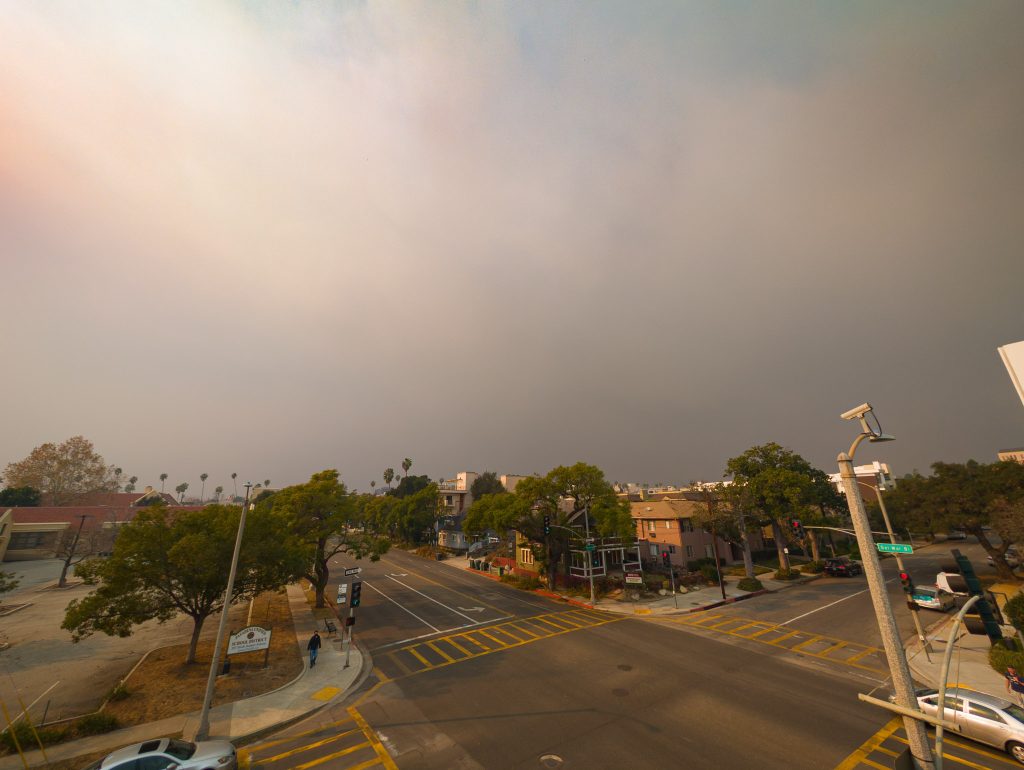As if we needed anything else to worry about…even if we didn’t have to pack up and evacuate from an unprecedented series of wildfires in Los Angeles, the additional insidiousness we all face There is a threat of That’s dangerous air quality from wildfire smoke. , a UC study found it to be up to 10 times more toxic than regular air pollution. Everyone, even those who are not in immediate danger from the flames, should take precautions to avoid smoke inhalation both outdoors and at home.
Immediately after the Palisades Fire broke out on January 7, the Los Angeles County Department of Public Health issued a smoke advisory (currently in effect until 5 p.m. today) and declared the air quality in Los Angeles County to be unhealthy. . And because of the strong winds we were dealing with, the wildfire smoke spread far beyond just the fire site.
If you receive your news from your local station, you’ve probably seen maps on the news that track the air quality in your area, labeled with colors and numbers. Air Quality Index (AQI) is how the U.S. Environmental Protection Agency measures outdoor air quality and health. The higher the index number, the unhealthy the air. Specifically, anything less than 100 is generally considered safe (yellow is fine, green is better). Values between 101 and 150 (orange) are considered unhealthy for sensitive groups. 151-200 (red) is unhealthy for everyone. 201-300 (purple) is very unhealthy. And finally, anything above 301 (maroon) is dangerous.
The agency considers five factors when determining air quality: ground-level ozone, particulate pollution (also known as particulate matter, which also includes PM2.5 and PM10), carbon monoxide, sulfur dioxide, and nitrogen dioxide. I am considering it. PM2.5 are respirable particulates consisting of microscopic solids or liquid droplets. These are particularly dangerous to health because they can be inhaled deep into the lungs and even into the bloodstream, causing long-term effects.
For the latest information on air quality in your area, visit the South Coast Air Quality Management District to view an interactive map. Another option is airnow.gov (there’s also an app; you can also check it through your phone’s weather app). Enter your address or postal code to see automatic air quality readings and a breakdown of pollutants in your area. As of this writing, Malibu is No. 260, Pacific Palisades is No. 174, Pasadena is No. 172, Hollywood is No. 157 and parts of La Crescenta-Montrose are No. 198. Temperatures on Catalina Island are reaching 370 degrees and are extremely dangerous. You can also view Purple Air’s crowdsourced map of air quality sensors. Air quality sensors may be located just a few blocks away. However, please note that these numbers may differ from the official numbers in the event of extreme smoke.
Even when the economy is strong, air pollution in Los Angeles is a problem. According to the American Lung Association, Los Angeles/Long Beach ranks No. 1 for most ozone pollution among U.S. metropolitan areas, No. 6 for year-round particle pollution, and No. 11 for short-term particle pollution. It is ranked number one. areas exposed to pollution from wildfire smoke). Believe it or not, this is actually an improvement compared to the city’s level in 2000.
So what can you do to avoid breathing in the harmful pollutants found in smoke? Here are the Public Health Agency’s recommendations:
First, check the air quality in your area. If you are in a danger zone, stay indoors as much as possible. (Children should especially be kept indoors because their lungs are still developing.) Close doors and windows when there is smoke outside (When air quality improves, get some fresh air. (You can open the door to reduce indoor pollution). Make sure your air conditioner’s filter is clean, then run it on a recirculation setting to avoid inhaling smoke from outside. Indoor activities that worsen air quality, such as smoking, lighting candles or incense, cooking on gas stoves, vacuuming, using aerosol sprays, and wearing shoes indoors, which can spread pollutants. Please avoid. Use an air purifier or make your own using a box fan and air filter (see how here).
When cleaning, use a damp mop or cloth to avoid splashing irritants. If you must go outdoors in smoke, limit exposure time, avoid strenuous physical activity, and cover up with an N95 mask. Oh, and keep your four-legged friends inside.
Stay calm and follow these tips. Hopefully that will help us all breathe easier soon.
Source link




